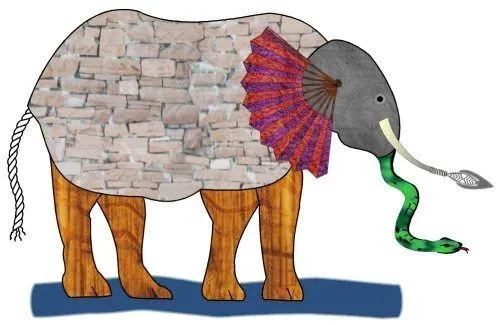Why We See The Clouds And Miss The Sky
What is nothing? Can it actually exist? And where does it come from? It’s murky metaphysical ground, to say the least.

And the importance of noticing the spaces in between
I remember looking up and being awed by the silhouette of these moody mountains and the grandeur of these giant Cumulus clouds. But, I don’t remember noticing that blue sky.
The emptiness of the sky is like the white space between these black letters. The darkness before dawn. The silence when the music stops. The absence of a loved one. Or the lack of water on a hot day.
What all these things have in common is that none of them actually exists. For example, noise exists, but silence is only the absence of it. This is what philosophers fondly refer to as “negative reality”. It is a reality made up of non-things, non existents, perceptions of absence, and other types of nothing. These are the humble spaces, silences, gaps and holes in our lives.
Despite not existing, these are unmistakable elements of our everyday experience. They are very real. They can have a powerful impact on us emotionally and physically. They can drive us to madness, or even kill us.
“Of course it is happening inside your head, Harry, but why on earth should that mean that it is not real?”
— Albus Dumbledore
(That’s the Albus in Harry Potter and the Deathly Hallows by J.K. Rowling)
The strangeness of nothing
What is nothing? Can it actually exist? And where does it come from? It’s murky metaphysical ground, to say the least. If we turn to science for a better framing, we might be disappointed.
Scientifically, all concrete things are positioned in space and time, but of course, this can’t apply to space or time itself. Where would space be? (And when would time be?). This question can only be answered if space were contained in another, higher, space, pushing us into an infinite regress.
Physicists tend to define nothing as “undifferentiated potential.” Not exactly catchy, but it certainly conveys a dynamic quality to nothing.

Prejudice against negative reality
As a society, we are biased against nothing. Philosophy, science and the culture of materialism, all encourage a positive reading of reality. What exists, intuitively feels more real, tangible and, well, important somehow.
We even tend to appreciate positive facts more than negative ones. Let’s look at this example from philosopher Sorensen Roy.
Fact 1: Elephants are huge.
Fact 2: Elephants do not fly.
Fact 3: Elephants do not exist in Africa.
Most of us will have a strong intuition that Fact 1, a positive truth, is more fundamental than Fact 2, a negative truth. It seems we are not that interested in what elephants don’t do.
Fact 3 is even more intriguing because it is a negative truth and yet it feels intuitively important. Philosopher Roy explains that this is because it expresses a frustrated expectation; we expect elephants in Africa.
Similarly, suppose you make a plan to see your friend Pierre for lunch. If he didn’t show up, you would notice! This is, again, because of a frustrated expectation. Other negative truths, such as the fact that many other uninvited friends are also not present for lunch, probably don’t come to mind.

We only appreciate space, when it’s gone
Another context in which we take negative reality seriously is when a non-thing we take for granted, suddenly disappears.
We notice the lack of space in a room when it gets really cluttered. We notice the lack of silence when the noise from the street becomes maddening. We notice the non-judgment of an old friend when we are in the harsh company of those that are quick to judge us. In the wise words of Janet Jackson, we really don’t know what we’ve got ’til it’s gone.
It appears that for the most part, we don’t pay much attention to what’s not there. We could even say that we treat negative reality as a parasite, deriving meaning only from its positive counterpart.

Artists as defenders of negative space
Artists have a different view. They have long challenged our societal bias towards positive reality. They argue that we can hear silence, and seedarkness, and that these acts of perception are far more meaningful than just noticing the absence of something else. For artists, nothing is something.
For artists, nothing is something.
Painters, graphic designers and photographers never tire of emphasising the significance of negative space in telling a story. Negative space is the space within, between, and around objects. Sometimes referred to as “white space” (though it is not always white), these areas are crucial in composing a sense of balance and unity. The space allows the eyes to breathe.

At a drawing class, a common teaching technique is to ask students to draw negative space. Imagine there is a chair in the front of the room. The student carefully draws the contours of the space outside of chair, and then fills this space with a single tone, such as black, leaving the positive space of the chair blank or white. This process reverses how we would normally draw the image of a chair, and is believed to use a different part of the brain. Artists claim that this approach offers freshness to an image.

Can you hear silence?
Musicians can equally be found waxing lyrical about the sound of the silence. They often treat silence not as emptiness, but as substance, as sound.
When you listen to music you may have noticed that the silent parts are ever-changing. Silence can feel so different, at different points in a single composition. Sometimes soothing, and at other times shocking.
Music then, includes the spaces between the notes. Some even say that the spaces are the most important feature of music.
”It’s not the notes you play, it’s the notes you don’t play.”
— Miles Davies
The composer John Cage famously explored the idea of silence as music with his 4’33″ (four minutes, thirty-three seconds). The composition consists entirely of silence. The performer simply goes on stage and sits at a piano. It has become an iconic work of art, and also the cause of much controversy. From when it was first performed in 1952 until today, many listeners reject the claim that this is really “music”.
Hear it for yourself:
4′ 33″, by John Cage, performed here by virtuoso pianist William Marx.
The very real possibility
Possibilities are another form of negative reality. Even without considering parallel realities, there are a huge number of alternative ways in which any situation could unfold. Negative space is a gateway for all possibilities, a permission slip for our imaginations to play.
These possibilities, or non-events (because they haven’t actually happened), can feel very real and have a profound impact on us. For example, thinking about one’s own death can lead to a shift in the meaning we make of our lives. Or thinking creatively about the possibilities in the future of tech can lead to game-changing innovations. Being able to see what’s not there is a gift.
Negative space is a permission slip for our imagination to play.
Take a look at this playful photograph below. The ink droplet precariously dangling over the crisp white shirt is probably starting to raise your adrenaline levels a little. It’s an energising photograph because it invites the imagination to come into play.

This next photo of a groom’s face in anticipation is so tangible. You may be able to imagine him turning around with a big smile when he sees her running towards him. The thought might bring a smile to your heart. Even though, nothing has actually happened.

Seeing the full picture
The existence and role of nothingness in our lives is an enquiry that philosophers have been wrestling with for centuries, from Plato and Aristotle through to Sartre and now us. While we work on a resolution to this puzzle, we cannot deny the richer perspective that observing spaces, holes and gaps offers. It is important, at times, to simply “watch this space”.
Perhaps we can treat the two realities — positive and negative — as the yin and yang of our ephemeral world. Connected and mutually interdependent. And both worthy of noticing, if we want the full picture.

Noticing – Our Newsletter
Join our newsletter community for monthly inspiration to slow down and stay curious about everyday life and what matters most to you.




